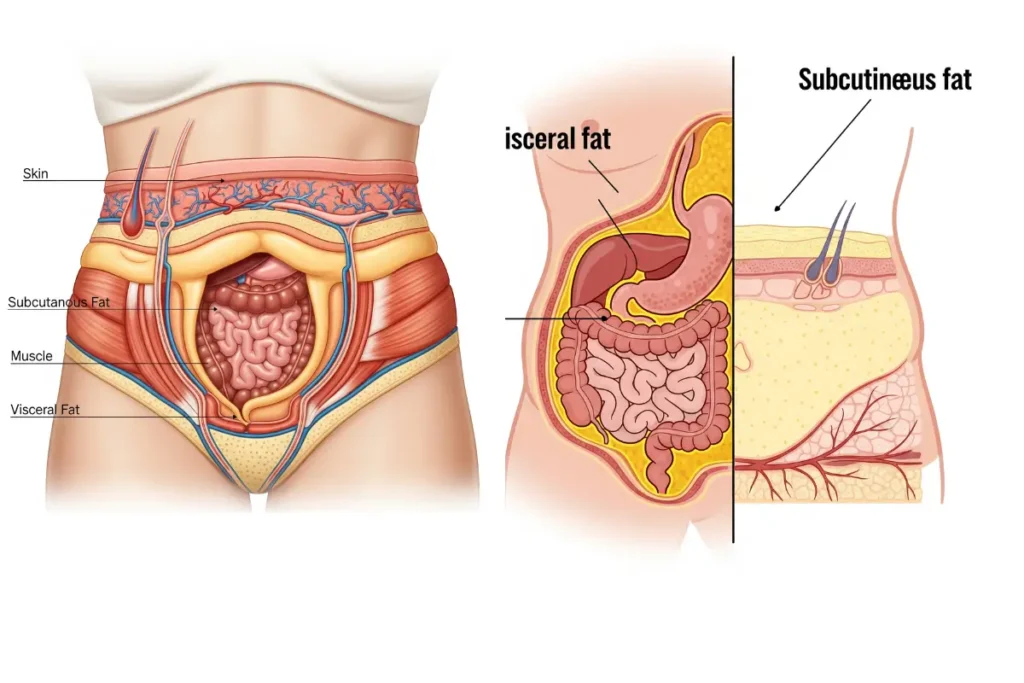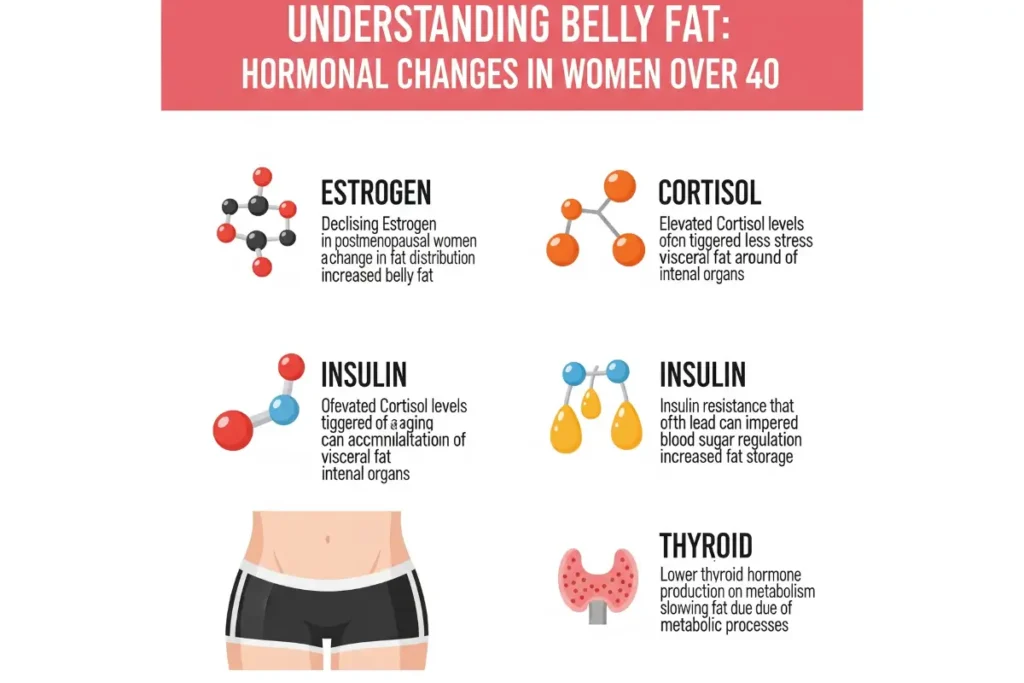Hey everyone, are you seeing some stubborn belly fat that won’t go away? It doesn’t matter how healthy you eat or how often you work out. You’re not alone.
This unexpected weight gain around the midsection is incredibly common for women over 40, and it’s not your fault. Let’s break down what’s really going on with hormonal changes and how you can take back control and support your long-term weight loss and quality of life.
What Is Hormonal Belly Fat?
Hormonal belly fat refers to excess fat that gathers deep in your belly because of shifts in hormone levels, which often occur as you get older. This isn’t the soft fat just under the skin (called subcutaneous fat). This type of fat, known as visceral fat, surrounds internal organs like your liver and intestines. Because of where it is, it can be harder to lose and more dangerous to your health (CDC: The Health Risks of Visceral Fat).
Signs It Might Be Hormonal:
If you’re seeing any of these, hormones could be the reason:
- Your belly suddenly feels bigger or firmer, even though you haven’t changed your habits.
- You’re tired all the time, have trouble sleeping, or feel moody.
You’re gaining body weight even though your eating and regular exercise haven’t changed.
Hormonal Belly Fat vs. Bloating
Bloating can make your stomach puff out, but it’s usually soft and temporary, like after a large meal or before your period. Hormonal belly fat, on the other hand, builds up over time and tends to feel firm. It doesn’t go away after a few hours or with a bathroom trip.

Hormonal Changes After 40: What’s Happening in Your Body
After 40, your body undergoes a variety of hormonal changes that affect everything from fat storage and metabolism to mood and sleep. These changes don’t just influence your appearance—they can also increase the risk of chronic medical conditions like type 2 diabetes, heart disease, and depression.

Estrogen Decline
Estrogen is one of your key sex hormones, and its levels naturally decline as you move through perimenopause and menopause. This drop shifts how your body handles fat storage, from your hips and thighs to your belly (NIH: Menopausal Hormone Therapy Information). Low estrogen may also impact hormone production overall, affecting your energy, mood, and how well you respond to diet and exercise.
Cortisol Increase

Cortisol is your body’s main stress hormone, produced by the adrenal glands. Chronic stress leads to high cortisol levels, which plays a role in increasing abdominal fat. This not only affects how you feel, but also increases the risk of emotional eating and disrupted sleep, which further fuel weight gain and hormonal imbalances (Harvard Health: Why Stress Causes People to Overeat).
Insulin Resistance
Insulin helps your cells absorb sugar for energy. After 40, many women become less sensitive to insulin. This insulin resistance causes your body to store more fat—especially in your belly—and increases the risk of developing type 2 diabetes (NIH: Insulin Resistance and Prediabetes).
Thyroid Function
Your thyroid hormones control how fast you burn calories. When your thyroid is underactive, your metabolism slows down. Symptoms include fatigue, mood swings, and difficulty losing weight. This condition, called hypothyroidism, also leads to cold sensitivity and an increased risk of weight-related health issues (NIH: Thyroid and Metabolism).
Real Reasons Behind the Fat Gain
Poor Sleep
Inadequate sleep disrupts key hormones like cortisol, leptin, and ghrelin. This not only makes you hungrier but also slows down your metabolism. Poor sleep also affects decision-making and willpower, which can sabotage even the best healthy lifestyle goals (NIH: Sleep Deprivation and Obesity).
Chronic Stress & Emotional Eating
Constant stress causes your adrenal glands to pump out cortisol all day long. This makes you crave sugar, increases fat storage in your belly, and sets the stage for long-term hormonal imbalances. Stress-related overeating doesn’t just impact your waistline—it can take a toll on your quality of life too.
Sedentary Lifestyle
A lack of movement not only reduces calorie burn but also weakens muscle, which is essential for a healthy metabolism. Sitting too much contributes to fat storage and makes it harder to lose weight, even with a clean diet.
Age-Related Metabolic Slowdown
As we age, hormone production declines and muscle mass naturally decreases. This leads to a slower metabolism and an increased risk of storing belly fat. Even if your habits haven’t changed, your body’s ability to burn calories likely has— but you can regain metabolic control after 40 with the right strategies.
How to Reduce Hormonal Belly Fat: Actionable Strategies
Nutrition Pro Tips:

- Focus on whole, anti-inflammatory foods.
- Eat protein with every meal to reduce cravings.
- Add fiber for steady blood sugar.
- Cut out sugar, processed foods, and alcohol.
Exercise Pro Tips:
- While cardio is great, adding strength training is essential.
- Mix in walking, dancing, and yoga for variety.
- Consider short HIIT sessions to boost metabolism and burn fat more efficiently.
Lifestyle Pro Tips:
- Prioritize 7–9 hours of quality sleep.
- Create a calming routine for better stress management.
- Use journaling or symptom tracking to spot hormone patterns.
Medical Support Pro Tips:
- Ask for hormone testing if symptoms persist.
- Look into natural supplements with your provider.
- Consider HRT or bioidentical hormone therapy if appropriate.
Mindset Pro Tips:

- Give yourself grace — lasting progress happens gradually.
- Focus on how you feel, not just the scale.
- Celebrate small wins like better sleep or improved energy.
Lifestyle Pro Tips:
- Prioritize 7–9 hours of quality sleep.
- Create a calming routine for better stress management.
- Use journaling or symptom tracking to spot hormone patterns.
Medical Support Pro Tips:
- Ask for hormone testing if symptoms persist.
- Look into natural supplements with your provider.
- Consider HRT or bioidentical hormone therapy if appropriate.
Mindset Pro Tips:
- Give yourself grace — lasting progress happens gradually.
- Focus on how you feel, not just the scale.
- Celebrate small wins like better sleep or improved energy.
Conclusion
Dealing with hormonal belly fat after 40 can feel discouraging — but you are not alone, and it’s not a life sentence. By understanding what’s happening in your body and making simple, sustainable changes to your diet and exercise, sleep, and stress levels, you can make a meaningful difference. Whether it’s tweaking your meals, lifting weights, or finally getting your hormones tested, every step you take helps your body work with you — not against you.This isn’t about perfection. It’s about taking steady, meaningful steps forward. And more importantly, it’s about reclaiming your energy, confidence, and quality of life.
FAQs
What does a hormonal belly look like on a woman?
A hormonal belly often looks round and firm, centered around the lower abdomen. It may feel different from bloat or fat in other areas and is typically associated with symptoms like fatigue, mood changes, or poor sleep.
How do I get rid of hormonal belly fat?
To reduce hormonal belly fat, focus on hormone-balancing foods, regular strength training, stress reduction, sleep improvement, and — when needed — professional guidance like hormone testing and treatment options.
Which hormone causes an increase in belly fat?
Cortisol, insulin, and estrogen all play a role. High cortisol (from stress), insulin resistance, and declining estrogen can all shift your body toward storing more belly fat.
Will taking estrogen reduce belly fat?
For some women, estrogen therapy may help reduce belly fat if low estrogen is the root cause. It’s best to speak with a healthcare provider to explore your personal risks, benefits, and treatment options.
Is hormonal belly reversible?
Yes, in many cases, hormonal belly fat is reversible with the right lifestyle changes, medical support, and consistency over time.